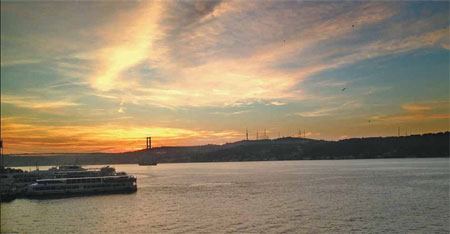On the great divide
Updated: 2013-11-03 08:16
By Pauline D. Loh(China Daily)
|
|||||||||
It is an ancient city that sits squarely between two continents, and a place where history meets and greets modern visitors with grace and hospitality. Pauline D. Loh visits Turkey's capital on the Golden Horn.
Istanbul.
The very name itself conjures up exotic images of veiled belly dancers, whirling dervishes, blue waters and flashes from Indiana Jones and The Raiders of the Lost Ark. In reality, Istanbul is a vibrant city that straddles cultures and continents.
The Golden Horn, an inlet of the Bosphorus Straits, cuts the city neatly into two, separating its European side from its Asian portion. Most tourists would land in Istanbul in Asia and be ferried to their hotels in Europe across the landmark Bosphorus Bridge.
We were fortunate enough to stay at the Shangri-La Bosphorus, which overlooks this famous stretch of water and has a most illustrious neighbor in the Dolmabahce Palace - one of several in Istanbul filled with glittering gold and crystals accompanied by narratives that sound like extracts from A Thousand and One Nights.
It is one of the first sights we visit. Although photographs are forbidden within the palace, we manage to capture images of the lovely garden, with its picturesque landscaping, fountains, playful statues of lion families and that million-dollar view of the Bosphorus.
Visitors cannot help but be awed by the sense of history here even as they enjoy all the luxuries of modernity.
As Constantinople, it was a city founded by Constantine the Great around AD 300 and went on to serve four empires under Roman, Byzantine, Latin and Ottoman rulers. Constantine converted to Christianity and his capital became a regional center for the faith for a long time until the Muslim Ottoman sultans conquered the city in the 15th century.
To understand modern-day Turkey, get the historical facts right and you will truly appreciate its cultures and relics including the impressive underground water cisterns, the Roman-styled obelisks at the Hippodrome, the originally Christian Hagia Sophia which inspired the later-day Blue Mosque.
Hagia Sophia, apart from its celebrated architecture, is also a reflection of the city's changing fortunes, having turned from church to mosque to museum.
But it is the other museums and palaces in Istanbul that will keep the visitor very busy, including the unique Museum of Innocence.
As in so many other things in Istanbul, the Museum of Innocence sends visitors into the Great Divide. This time, it is the dim recesses between fact and fiction, dream and reality.
The Museum of Innocence is also a novel by Turkish Nobel Laureate Orhan Pamuk, published in 2008. The physical building is a collection of memorabilia from the star-crossed romance of the protagonists - a wealthy businessman and a lowly shop girl.
It is a testament, too, to the author's creative process. At the entrance is an entire wall studded with cigarette butts from the smokes he shared with friends while writing the novel, and each stub is carefully documented with name and date.
To the visitor, though, the exhibits give a rare glimpse into some intensely personal details of life in Istanbul during the 1970s to 1980s, even as they wonder which is truth and which came from the imagination of the novelist.
As we emerge from the cavernous depth of the museum, it is to walk through the steep lanes that thread the hills, filled with little flea markets, antique shops and fruit stalls offering juice freshly squeezed from ruby-red pomegranates.
This exotic fruit is much loved here, and piles of it can be seen everywhere. One of my souvenirs from Istanbul is a group of three ceramic pomegranates, bursting at the seams with sparkling red glass seeds.
It also appears often in motifs and graphics from the palace walls to the carpets sold at the Great Bazaar. At the Egyptian Market, the most delicious Turkish delights were dimly glowing squares made from pomegranates, almonds, pistachios and Turkey's famous honey.

And yes, this is a land of milk and honey, and olives and grapes, peaches and figs.
Istanbul is a gourmet's delight, with delicious offerings everywhere. Street corner vendors offer Turkish breads that look like giant pretzels, roasted chestnuts and corncobs, trays of steamed mussels served with wedges of lemon, and, of course, the ubiquitous kebabs, baklavas and sweetmeats.
These compete with restaurants that offer dinners a glimpse into Turkish cuisine, mainly based on lamb but also featuring beef and seafood.
Turkish coffee is an experience for the strong-hearted - so strong it is almost semi-solid and so potent it may give you palpitations. It is the tea I like best, served in elegant glasses with nipped-in waists, sweetly energizing after a long day of sightseeing.
Istanbul is like a Turkish hors d'oeuvre, a tantalizing taste of things to come.
Already, I am saving up and planning a more thorough exploration of this delightful, surprising country, full of colorful sights and sounds.
Contact the writer at paulined@chinadaily.com.cn.
|
Sunrise over the Bosphorus seen from the room balcony of the strategically located Shangri-La Istanbul. Photos by Pauline D. Loh / China Daily |

(China Daily 11/03/2013 page16)
